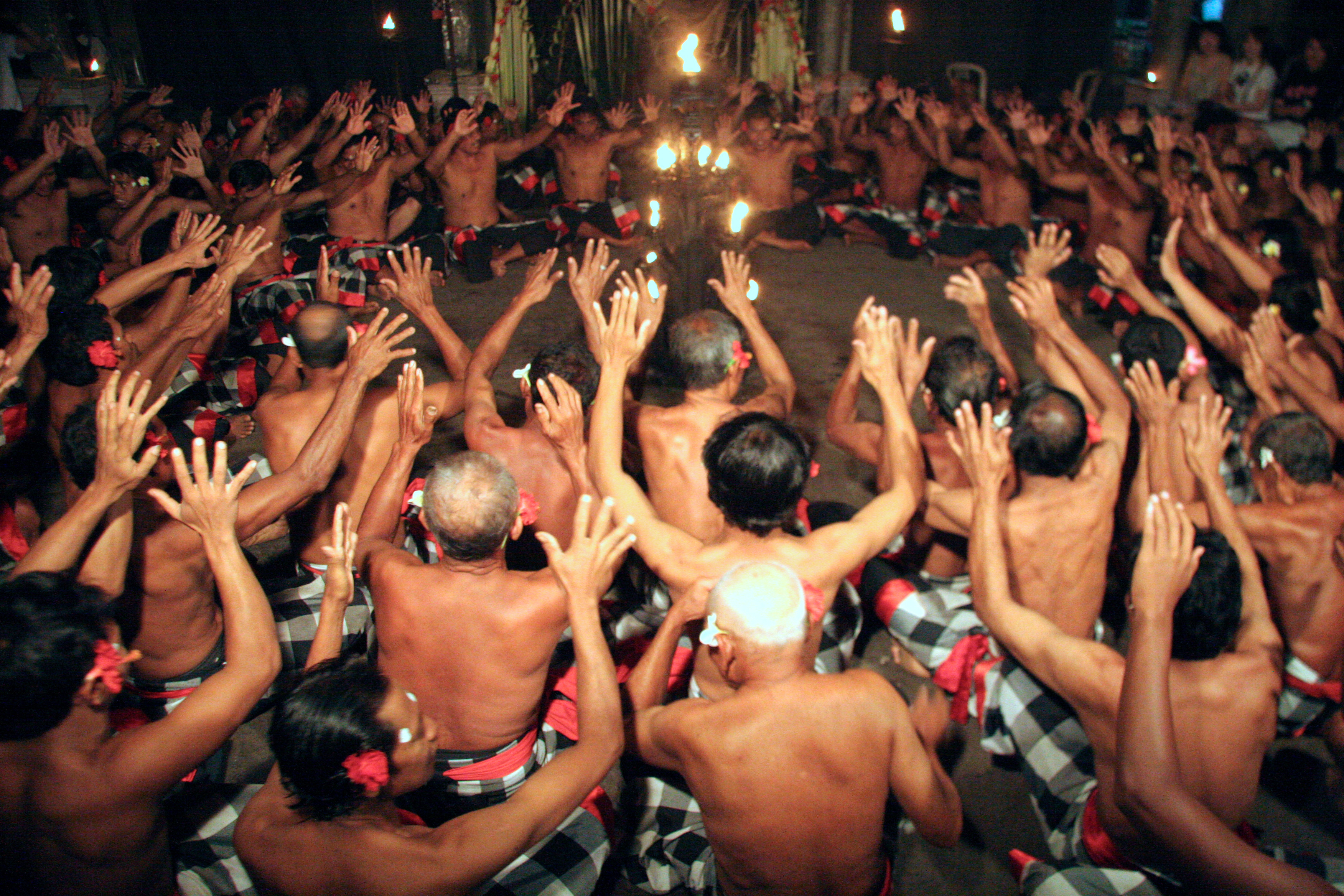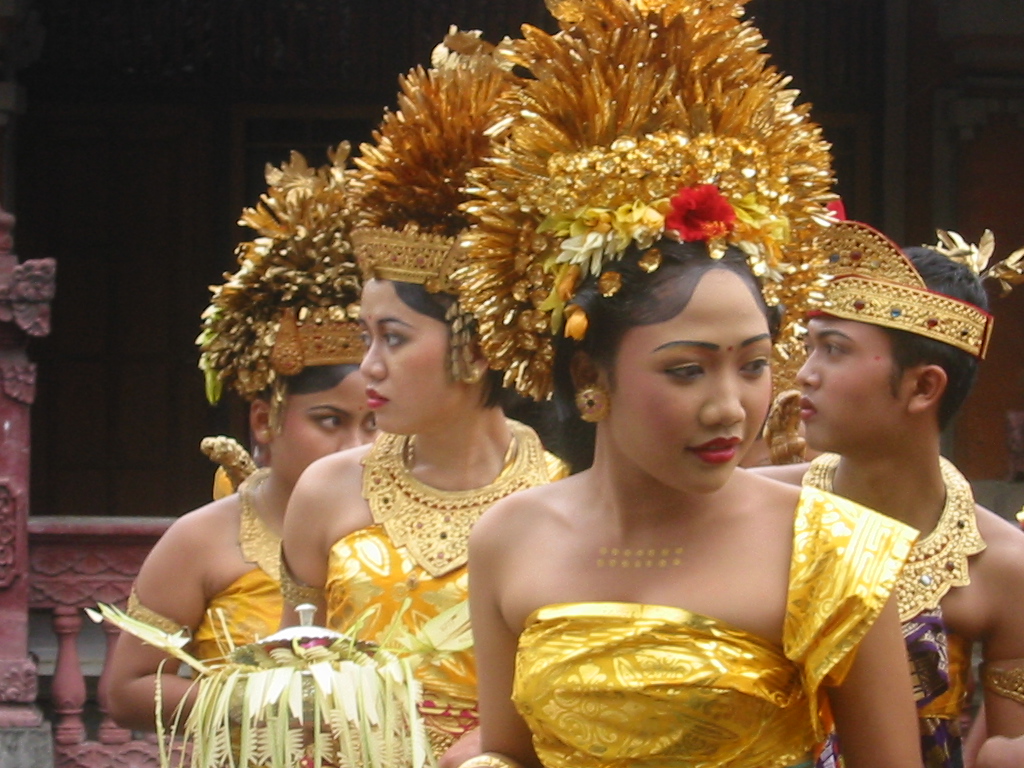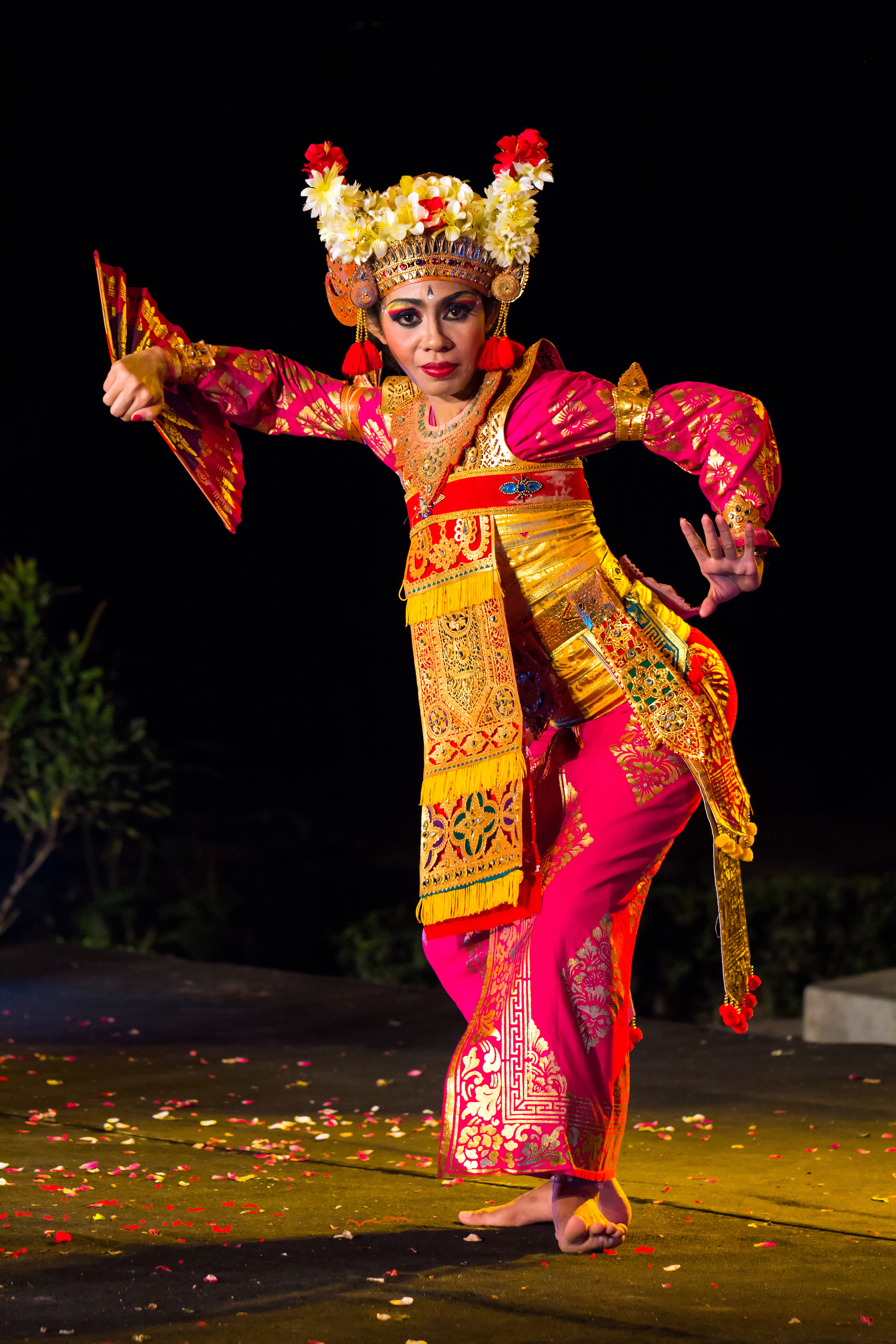Balinese dance on:
[Wikipedia]
[Google]
[Amazon]

 Balinese dance ( id, Tarian Bali; ban, ᬇᬕᬾᬮᬦ᭄ᬩᬮᬶ) is an ancient dance tradition that is part of the religious and artistic expression among the Balinese people of Bali island,
Balinese dance ( id, Tarian Bali; ban, ᬇᬕᬾᬮᬦ᭄ᬩᬮᬶ) is an ancient dance tradition that is part of the religious and artistic expression among the Balinese people of Bali island,
 In
In
 In Bali there are various categories of dance, including epic performances such as the omnipresent ''
In Bali there are various categories of dance, including epic performances such as the omnipresent ''
 Bali dancers learn the craft as children, they are played Balinese music. They are taught to dance with their hands before they can walk. Official training as a Bali dancer starts as young as 7. In Balinese dance the movement is closely associated with the rhythms produced by the gamelan, a musical ensemble specific to Java and Bali. Multiple levels of articulations in the face, eyes, hands, arms, hips, and feet are coordinated to reflect layers of percussive sounds.
The number of codified hand positions and gestures, the mudras, is higher in India than in Java or Bali. It has been speculated that they have been forgotten as the dance was transmitted from India to Java. Hand positions and gestures are nonetheless as important in Javanese and Balinese dance as in India.''A Dictionary of Theatre Anthropology: The Secret Art of the Performer'' by E. Barba (2005) p.156 Whether in India, Indonesia or
Bali dancers learn the craft as children, they are played Balinese music. They are taught to dance with their hands before they can walk. Official training as a Bali dancer starts as young as 7. In Balinese dance the movement is closely associated with the rhythms produced by the gamelan, a musical ensemble specific to Java and Bali. Multiple levels of articulations in the face, eyes, hands, arms, hips, and feet are coordinated to reflect layers of percussive sounds.
The number of codified hand positions and gestures, the mudras, is higher in India than in Java or Bali. It has been speculated that they have been forgotten as the dance was transmitted from India to Java. Hand positions and gestures are nonetheless as important in Javanese and Balinese dance as in India.''A Dictionary of Theatre Anthropology: The Secret Art of the Performer'' by E. Barba (2005) p.156 Whether in India, Indonesia or
File:Bali-Danse 0726a.jpg, A man dancing Balinese ''Barong''.
File:Tari Tenun Nyoman Hendra Adhi Wibowo.jpg, Balinese ''Tari tenun'' (weaving dance) mass dance, performed by hundreds of dancers.
File:Pendet Dance.jpg, Balinese ''Tari pendet'', performed by hundreds of dancers.
File:Learn to Dance.jpg, Balinese people learn to dance since childhood. Balinese dance is a living tradition incorporated within the everyday way of life.
File:Bali-Danse 0705a.jpg, ''

 Balinese dance ( id, Tarian Bali; ban, ᬇᬕᬾᬮᬦ᭄ᬩᬮᬶ) is an ancient dance tradition that is part of the religious and artistic expression among the Balinese people of Bali island,
Balinese dance ( id, Tarian Bali; ban, ᬇᬕᬾᬮᬦ᭄ᬩᬮᬶ) is an ancient dance tradition that is part of the religious and artistic expression among the Balinese people of Bali island, Indonesia
Indonesia, officially the Republic of Indonesia, is a country in Southeast Asia and Oceania between the Indian and Pacific oceans. It consists of over 17,000 islands, including Sumatra, Java, Sulawesi, and parts of Borneo and New Gui ...
. Balinese dance is dynamic, angular and intensely expressive. Balinese dancers express the stories of dance-drama through the bodily gestures including gestures of fingers, hands, head and eyes.
There is a great richness of dance forms and styles in Bali; and particularly notable are those ritualistic dance dramas which involve Rangda, the witch, and the great beast Barong. Most of the dances in Bali are connected to Hindu
Hindus (; ) are people who religiously adhere to Hinduism. Jeffery D. Long (2007), A Vision for Hinduism, IB Tauris, , pages 35–37 Historically, the term has also been used as a geographical, cultural, and later religious identifier for ...
or traditional folk rituals, such as the Sanghyang
( ban, ᬲᬂᬳ᭄ᬬᬂ) is a traditional sacred Balinese dance originated from the Indonesian island of Bali, it is based on the premise that an unseen force enters the body of an entranced performer. The force, identified as ''hyang'' ...
Dedari sacred dance that invoke benevolent hyang spirits, believed to possess the dancers in a trance state during the performance. Other Balinese dances are not linked to religious rituals and are created for certain occasions or purposes, such as the Baris or Pendet welcoming dances and Joged
''Joged'' dance ( ban, ᬚᭀᬕᬾᬤ᭄) is a style of dance from the Island of Bali derived from the traditional Gandrung dance. The term ''joged'' or ''joget'' is also a common word for dance in Indonesia. The dance is typically accompanie ...
dance, that is social dance for entertainment.
Recognition and conservation
During the Intergovernmental Committee for the Safeguarding of the Intangible Cultural Heritage convention in 29 November to 4 December 2015 in Windhoek, Namibia,UNESCO
The United Nations Educational, Scientific and Cultural Organization is a List of specialized agencies of the United Nations, specialized agency of the United Nations (UN) aimed at promoting world peace and security through international coope ...
recognizes three genres of traditional dance in Bali, Indonesia, as Intangible cultural heritage. The three genres includes ''Wali'' ( sacred dances), ''Bebali'' (semi-sacred dances) and ''Balih-balihan'' (dances for entertainment purposes). Balinese dance has been proposed since 2011, and officially recognized in 2015.
The three genres are represented by nine dances, which describes its function and living tradition in Balinese community, they are:
;''Wali'' Sacred Dances
# Rejang (Klungkung District). Sacred ceremonial dance by young women in traditional ceremonial dress,
# Sanghyang Dedari (Karangasem District). Sacred trance dance to counteract negative supernatural forces. Performed by two young girls.
# Baris Upacara (Bangli District) religious dances conveying heroic spirit danced by even numbers of male dancers.
;''Bebali'' Semi Sacred Dances
# Topeng Sidhakarya/Topeng Pajegan (Tabanan District). Performed by masked dancers to neutralize the evil spirits.
# Gambuh dance drama (Gianyar District). Formerly royal theatrical performance, now accompaniment to ceremonies, by 25-40 dancers.
# Wayang Wong dance drama (Buleleng District). Combines dance, epic drama and music.
;''Balih-balihan'' Entertainment Dances
# Legong Kraton (Denpasar City). Exquisitely beautiful dance by 2 or 3 girls. Developed from Sanghyang Dedari, and Gambuh.
# Joged Bumbung (Buleleng District). A popular social dance by couples, during harvest season or on important days.
# Barong Ket "Kuntisraya" (Badung District). Represents a fight between two mythological characters, Barong in the form of a lion symbolizing goodness and Rangda, an evil witch.
Significance
Hinduism
Hinduism () is an Indian religion or '' dharma'', a religious and universal order or way of life by which followers abide. As a religion, it is the world's third-largest, with over 1.2–1.35 billion followers, or 15–16% of the global p ...
, dance is an accompaniment to the perpetual dissolving and reforming of the world. The creative and reproductive balance is often personified as Shiva
Shiva (; sa, शिव, lit=The Auspicious One, Śiva ), also known as Mahadeva (; Help:IPA/Sanskrit, ɐɦaːd̪eːʋɐ, or Hara, is one of the Hindu deities, principal deities of Hinduism. He is the Supreme Being in Shaivism, one o ...
's wife, Durga
Durga ( sa, दुर्गा, ) is a major Hindu goddess, worshipped as a principal aspect of the mother goddess Mahadevi. She is associated with protection, strength, motherhood, destruction, and wars.
Durga's legend centres around c ...
, sometimes called Uma, Parvati
Parvati ( sa, पार्वती, ), Uma ( sa, उमा, ) or Gauri ( sa, गौरी, ) is the Hindu goddess of power, energy, nourishment, harmony, love, beauty, devotion, and motherhood. She is a physical representation of Mahadevi i ...
, or Kali
Kali (; sa, काली, ), also referred to as Mahakali, Bhadrakali, and Kalika ( sa, कालिका), is a Hindu goddess who is considered to be the goddess of ultimate power, time, destruction and change in Shaktism. In this tra ...
. This has significance in Balinese Hinduism
Hinduism () is an Indian religion or '' dharma'', a religious and universal order or way of life by which followers abide. As a religion, it is the world's third-largest, with over 1.2–1.35 billion followers, or 15–16% of the global p ...
, since the common figure of Rangda is similar in many ways to Durga
Durga ( sa, दुर्गा, ) is a major Hindu goddess, worshipped as a principal aspect of the mother goddess Mahadevi. She is associated with protection, strength, motherhood, destruction, and wars.
Durga's legend centres around c ...
.
Variants
 In Bali there are various categories of dance, including epic performances such as the omnipresent ''
In Bali there are various categories of dance, including epic performances such as the omnipresent ''Mahabharata
The ''Mahābhārata'' ( ; sa, महाभारतम्, ', ) is one of the two major Sanskrit epics of ancient India in Hinduism, the other being the '' Rāmāyaṇa''. It narrates the struggle between two groups of cousins in the K ...
'' and ''Ramayana
The ''Rāmāyana'' (; sa, रामायणम्, ) is a Sanskrit epic composed over a period of nearly a millennium, with scholars' estimates for the earliest stage of the text ranging from the 8th to 4th centuries BCE, and later stages ...
''.
Certain ceremonies at village temples feature a special performance of a dance-drama, a battle between the mythical characters Rangda, the witch representing the evil, and Barong, the lion or dragon, representing the good. This type of performance was traditionally featured during outbreaks of epidemic diseases which were believed by the people to be a result of a disturbance in the balance of the 'good and bad forces', which were represented by the Rangda and the Barong. The battle usually reconciles in harmony or balance of the Rangda and the Barong, instead of a defeat of the evil.
Among the dance traditions in Bali are:
* Barong, king of the spirits
* Baris war dances
* Cendrawasih, the bird of paradise
*Condong
( ban, ᬘᭀᬦ᭄ᬤᭀᬂ) is a Balinese dance which is often performed as a preface to legong and accompanied by the semar pangulingan style of gamelan. The term also refers to a stock character, a quintessential representation of the mai ...
, a basic dance, preface to Legong
* Legong, a refined dance
* Kecak, the Ramayana monkey chant dance
*Janger
( ban, ᬚᬗᬾᬃ) is a traditional Balinese and Osing dance drama performance originated from the Indonesian island of Bali, and commonly performed by Balinese in Bali as well as Osing people in the easternmost region of Java. The term r ...
, a sitting dance with swaying movements
* Pendet, a simple dance performed before making an offering at a temple
*Tenun, a dance describes women weaving the cloth
*Topeng
''Topeng'' (from ban, ᬢᭀᬧᬾᬂ, su, ᮒᮧᮕᮨᮔᮌ, and jv, ꦠꦺꦴꦥꦺꦁ, topeng, mask) is a dramatic form of Indonesian dance in which one or more mask-wearing, ornately costumed performers interpret traditional narratives c ...
, a mask dance
Traditionally, sacred dances can only be performed in temples. However, new choreographies have been created due to the demand from tourists. One example, Tari Sekar Jagat (Tari means dance in the Balinese language), is a relatively new choreography that has become popular. In the newer creations, choreographers have more freedom over the moves. They use new moves that were considered 'improper' for the sacred dances. For example, in Tari Sekar Jagat, there is a move when the dancers hold the Dulang below their shoulders. This ceremonial pedestal, which may be wooden or ceramic, is normally held high in accordance with its sacredness. Below shoulder level but above the navel represents an ordinary or everyday state.
Technique
 Bali dancers learn the craft as children, they are played Balinese music. They are taught to dance with their hands before they can walk. Official training as a Bali dancer starts as young as 7. In Balinese dance the movement is closely associated with the rhythms produced by the gamelan, a musical ensemble specific to Java and Bali. Multiple levels of articulations in the face, eyes, hands, arms, hips, and feet are coordinated to reflect layers of percussive sounds.
The number of codified hand positions and gestures, the mudras, is higher in India than in Java or Bali. It has been speculated that they have been forgotten as the dance was transmitted from India to Java. Hand positions and gestures are nonetheless as important in Javanese and Balinese dance as in India.''A Dictionary of Theatre Anthropology: The Secret Art of the Performer'' by E. Barba (2005) p.156 Whether in India, Indonesia or
Bali dancers learn the craft as children, they are played Balinese music. They are taught to dance with their hands before they can walk. Official training as a Bali dancer starts as young as 7. In Balinese dance the movement is closely associated with the rhythms produced by the gamelan, a musical ensemble specific to Java and Bali. Multiple levels of articulations in the face, eyes, hands, arms, hips, and feet are coordinated to reflect layers of percussive sounds.
The number of codified hand positions and gestures, the mudras, is higher in India than in Java or Bali. It has been speculated that they have been forgotten as the dance was transmitted from India to Java. Hand positions and gestures are nonetheless as important in Javanese and Balinese dance as in India.''A Dictionary of Theatre Anthropology: The Secret Art of the Performer'' by E. Barba (2005) p.156 Whether in India, Indonesia or Cambodia
Cambodia (; also Kampuchea ; km, កម្ពុជា, UNGEGN: ), officially the Kingdom of Cambodia, is a country located in the southern portion of the Indochinese Peninsula in Southeast Asia, spanning an area of , bordered by Thailand ...
, hands have a typically ornamental role and emphasize the dance's delicate intricacy.
Gallery
Baris dance
''Baris'' dance ( ban, ᬩᬭᬶᬲ᭄) is a family of traditional war dances in Bali, Indonesia, accompanied by gamelan, in which dancers depict the feelings of a young warrior prior to battle, glorify the manhood of the triumphant Balinese wa ...
''
File:17 Years of Sekar Jepun 2014-11-01 72.jpg, ''Condong
( ban, ᬘᭀᬦ᭄ᬤᭀᬂ) is a Balinese dance which is often performed as a preface to legong and accompanied by the semar pangulingan style of gamelan. The term also refers to a stock character, a quintessential representation of the mai ...
''
File:Barisan Penari Bali.jpg, '' Legong''
File:Tari Pendet.jpg, '' Pendet''
File:Barong, Batubulan Village, Bali 1601.jpg, '' Barong dance''
File:Bali-Danse 0710a.jpg, ''Topeng dance
''Topeng'' (from ban, ᬢᭀᬧᬾᬂ, su, ᮒᮧᮕᮨᮔᮌ, and jv, ꦠꦺꦴꦥꦺꦁ, topeng, mask) is a dramatic form of Indonesian dance in which one or more mask-wearing, ornately costumed performers interpret traditional narratives ...
''
File:17 Years of Sekar Jepun 2014-11-01 42.jpg, '' Cendrawasih dance''
File:Sang Hyang Jaran.jpg, ''Sanghyang
( ban, ᬲᬂᬳ᭄ᬬᬂ) is a traditional sacred Balinese dance originated from the Indonesian island of Bali, it is based on the premise that an unseen force enters the body of an entranced performer. The force, identified as ''hyang'' ...
''
File:17 Years of Sekar Jepun 2014-11-01 52.jpg, '' Kebyar duduk''
File:Rejang Adat.jpg, ''Rejang dance
''Rejang'' dance ( ban, ᬋᬚᬂ) is a sacred Balinese dance, a sacrificial dance in which the girls offer themselves to the gods. It is usually held at the Hindu temple's of Klungkung Regency and Karangasem Regency in Bali, Indonesia. “Rej ...
''
File:17 Years of Sekar Jepun 2014-11-01 32.jpg, '' Oleg dance''
File:17 Years of Sekar Jepun 2014-11-01 46.jpg, ''Panyembrama
Panyembrama ( ban, ᬧᬜᭂᬫ᭄ᬩ᭄ᬭᬫ) is a secular Balinese dance form designed by I Wayan Berata and first performed in 1971. It includes movements from several sacral Balinese dances, which it was intended to replace for perform ...
''
See also
* Dance in Indonesia * Javanese dance * Sundanese dance *Dance of Cambodia
Dance in Cambodia ( km, របាំ ''robam'') consists of three main categories: classical dance of the royal court, folk dance which portrays cultural traditions, and social dances performed in social gatherings.
Classical dance
Cambodia ...
* Dance of Thailand
* Theatre in Bali
* Hinduism in Bali
* Dance in mythology and religion
* List of basic dance topics
* List of dance style categories
This is a list of dance categories, different types, styles, or genres of dance.
For older and more region-oriented vernacular dance styles, see List of ethnic, regional, and folk dances by origin.''
African and American
* Bolojo
* Cakewalk
...
* List of dances
References
External links
* {{DEFAULTSORT:Balinese Dance Balinese culture Dances of Indonesia Dances of Bali Ritual dances Partial squatting position